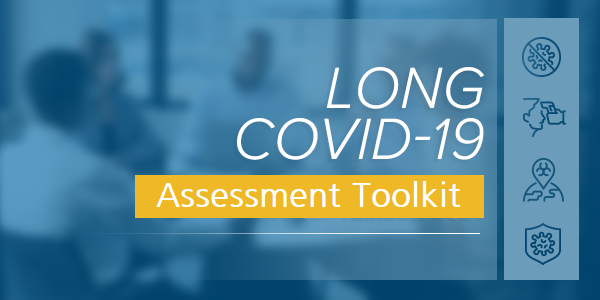Nearly two years since SARS-CoV-2 created a global pandemic, we know that some people may suffer from ongoing symptoms long after the effects of the initial phase of an acute infection.
In the first half of 2020, the terms “long COVID” or “Long Haulers” already gained popularity, with many people reporting that they were experiencing ongoing symptoms. Still, the exact mechanism of long COVID is not yet clear. There is no consistent definition nor accepted diagnostic criteria.
Even in normal times, disability assessment is an art as much as a science; assessors almost never have all the facts and must fill in missing information with scientific understanding and common sense. Yet in the case of these claims, scientific understanding is still forming as the COVID-19 virus evolves. That’s why claims experts from RGA’s global, South African and U.S. Group teams have developed a three-part long COVID Disability Claims Toolkit to help guide claims assessors in identifying potential long COVID claims, assessing disability claims, and preparing claimants, when possible, to return to work. See the end of this article for further details.
Round Table Discussion 
RGA’s Dr. Sheetal Salgonkar, Vice President and Medical Director, and Marilda Kotze, Vice President, Head of Global Claims, led a lively insurer roundtable discussion about ways to assess and address this complex constellation of conditions. RGA met with Sheetal and Marilda to revisit some of the more popular discussion topics and answer new questions:
Many in the industry appear to struggle to define long COVID. Why is that?
We’re talking about a wide range of more than 200 symptoms that defy easy categorization, vary in severity and duration, and can impact multiple organs. Even routine physical exertion, like light housework, leaves these individuals feeling exhausted. Some ache all over. Others have trouble concentrating and stumble over simple calculations or cannot fulfill regular responsibilities at home or at work. The most common complaints include fatigue, headache, pain, myalgia, attention disorder, hair loss, dyspnea, ageusia, and anosmia. There is also Post COVID tachycardia syndrome, which usually affects young women.
Although there has been no agreement on one universal definition for some time, more guidance is emerging. On October 6, 2021, the World Health Organization (WHO) published a clinical case definition:
“Post COVID-19 condition occurs in individuals with a history of probable or confirmed SARS-CoV-2 infection, usually 3 months from the onset of COVID-19 with symptoms that last for at least 2 months and cannot be explained by an alternative diagnosis. Common symptoms include fatigue, shortness of breath, cognitive dysfunction but also others and generally have an impact on everyday functioning. Symptoms may be new onset following initial recovery from an acute COVID-19 episode or persist from the initial illness. Symptoms may also fluctuate or relapse over time.”
Prior to the WHO clinical case definition being published, the U.K. National Institute for Health Research identified four subtypes of long COVID and the U.K. National Institute for Health and Care Excellence distinguished long COVID suffers as those with symptoms that linger four to 12 weeks after infection, with Post COVID appearing after 12 weeks-time. On the other hand, the U.S. National Institutes of Health names a single condition: Post-Acute Sequelae of COVID or PASC.
Speaking of timing, how long-lasting is long COVID?
The maximum duration of long COVID symptoms is currently unknown. Symptoms wax and wane in severity and differ among individuals.
Can you talk a little bit about testing and prevalence. What should claims teams understand?
There is no diagnostic test for long COVID – coronavirus antibodies wane naturally and may not be detectable in claimants with this condition. Of course, this can complicate tracking and testing. It doesn’t help that sufferers can present with an array of subjective complaints, such as fatigue, chronic pain, or brain fog, that are difficult to capture with traditional screens, blood tests or imaging.
Researchers have detected certain symptom patterns, though. Currently long COVID is more common in females and in people at younger ages. There is no evidence that the severity of a COVID-19 infection is an indicator of post viral symptoms; people who were asymptomatic or had mild COVID-19 symptoms can develop the condition. Still, admission to an intensive care unit is a very poor prognosticator for return to work, with only approximately 50% of people retuning to work one-year post ICU discharge.
RGA’s toolkit offers a symptom checker to help claims assessors identify combinations of symptoms that may point toward long COVID. Researchers are already identifying 12-week symptom profiles, including a cluster that share respiratory symptoms and another group that is more distinguished by deep fatigue.










